Zoom
Trash

Romanian orphans – a human tragedy, a scientific opportunity. We drove to the orphanage on a pleasant December morning, under a sky that seemed too blue.
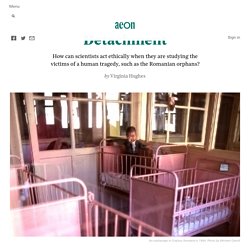
It was a short ride through a residential neighbourhood of Bucharest, littered with posters of politicians’ heads for the upcoming elections. Nervous, I mentally recited the two rules the American professor had given me the night before: no picking up the kids, and no crying in front of them. We pulled up to a dingy pink building, lined on all sides by tall wire fencing, and parked at the curb. After passing through the checkpoint of a stoic security guard, we stepped into an empty hallway. It was cleaner than I had expected; old plaster walls and chipped steps, yes, but no obvious filth.
What became of Romania's neglected orphans? English and Romanian Adoptee Study. The English and Romanian Adoptee (ERA) project is a longitudinal, multi-method investigation of the development of children adopted into the UK from Romania in the early 1990’s.

It has been part-funded by the Nuffield Foundation, most recently to enable a follow up of the children aged 15. The ERA, led by Professor Michael Rutter and Professor Edmund Sonuga-Barke, has followed a random sample of 165 Romanian children, most of whom had spent their early lives in institutions in which conditions ranged from poor to abysmal. Its aim is to examine the extent to which children could recover when extreme deprivation in early life is followed by a middle childhood within a safe family environment. The study has shown that children who experience extreme institutional deprivation will usually make a huge improvement in psychological functioning following successful adoption.
The evidence suggests that wider, more flexible criteria are possible for successful adoption within the UK. Is misused neuroscience defining early years and child protection policy? "Neuroscience can now explain why early conditions are so crucial," wrote Graham Allen and Iain Duncan Smith in their 2010 collaboration, Early Intervention: Good Parents, Great Kids, Better Citizens.
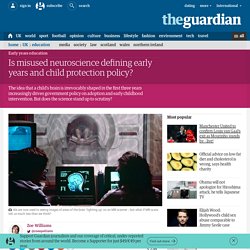
"The more positive stimuli a baby is given, the more brain cells and synapses it will be able to develop. " Neuroscience is huge in early years policy. This week, in what's been characterised as the largest shake-up of family law in a generation, the 26-week time limit for adoption proceedings has come into force, much of it justified by the now-or-never urgency of this set of beliefs, that the first three years (or sometimes first 18 months) hardwire a baby's brain, either give it or deny it the capacity for a full life.
The Determinist Myth of the Early Years. Tuesday 16 July 2013 Whether based on attachment theory or neurobabble, the claim that human beings are set in stone by the age of three is groundless.
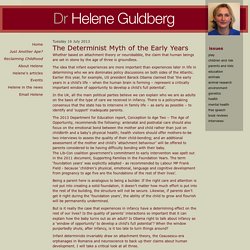
The idea that infant experiences are more important than experiences later in life in determining who we are dominates policy discussions on both sides of the Atlantic. Earlier this year, for example, US president Barack Obama claimed that ‘the early years in a child’s life – when the human brain is forming – represent a critically important window of opportunity to develop a child’s full potential’.
The deterministic myth of the ‘early years’ But is it really the case that experiences in infancy have a determining effect on the rest of our lives?
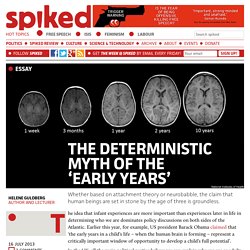
Is the quality of parents’ interactions so important that it can explain how the baby turns out as an adult? Is Obama right to talk about infancy as a ‘window of opportunity’ to develop a child’s full potential’? When the window purportedly shuts, after infancy, is it too late to turn things around? Infant determinists invariably draw on attachment theory, the Ceausescu-era orphanages in Romania and neuroscience to back up their claims about human development.
I will take a critical look at all three. Attachment Theory. What Happened to Romania's Irrecuperables? In 1990, the issue that catapulted Romania into the headlines in the West, after the rise and fall of Ceausescu, was the country’s orphanages.
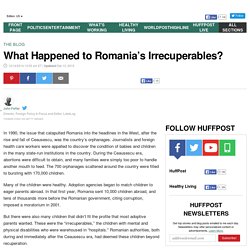
Journalists and foreign health care workers were appalled to discover the condition of babies and children in the many state-run institutions in the country. During the Ceausescu era, abortions were difficult to obtain, and many families were simply too poor to handle another mouth to feed. The 700 orphanages scattered around the country were filled to bursting with 170,000 children. Many of the children were healthy. Adoption agencies began to match children to eager parents abroad. But there were also many children that didn’t fit the profile that most adoptive parents wanted. Romanian Orphans Investigation. AIMS: One of the consequences of psychological research into the effects of institutionalisation - see Separation, Maternal Deprivation and Evaluating Bowlby - was to greatly reduce the extent to which children were placed in such care.
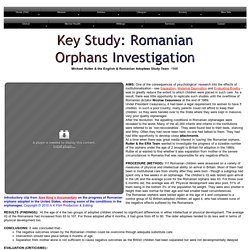
As a result, there was little opportunity to replicate such studies until the overthrow of Romanian dictator Nicolae Ceaucescu at the end of 1989. Under President Ceaucescu, it had been a legal requirement for women to have 5 children. In such a poor country, many parents could not afford to keep their children; so they were handed over to the State where they were kept in massive, very poor quality orphanages. Chugani. Saving a Lost Generation – The Rush to Adopt Romania’s Orphans - Association for Diplomatic Studies and TrainingAssociation for Diplomatic Studies and Training. The despotic reign of Romania’s Nicolae Ceauşescu caused deplorable living conditions for Romanians and left its most vulnerable citizens – abandoned children — to be literally warehoused.

Orphanages were overrun due to Ceauşescu’s policy of making abortions and contraception illegal while also practically forcing women to have at least four or five children. Most could simply not afford to keep their children and orphanages were unable to adequately care for the children placed there. Around 180,000 children lived in inhumane conditions – no heat, poor clothing, little food, and little health care. What became of Romania's neglected orphans? The Lost Children - Romania. Childhood neglect erodes the brain. In perhaps the most famous study of childhood neglect, researchers have closely tracked the progress, or lack of it, in children who lived as infants in Romania’s bleak orphanages and are now teenagers.
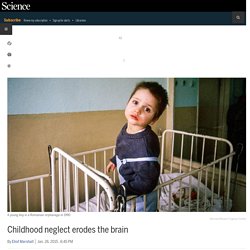
A new analysis now shows that these children, who display a variety of behavioral and cognitive problems, have less white matter in their brains than do a group of comparable children in local families. The affected brain regions include nerve bundles that support attention, general cognition, and emotion processing. The work suggests that sensory deprivation early in life can have dramatic anatomical impacts on the brain and may help explain the previously documented long-term negative effects on behavior. But there’s some potential good news: A small group of children who were taken out of orphanages and moved into foster homes at age 2 appeared to bounce back, at least in brain structure.
The orphanages have sharply reduced their intake today. Bick agrees on that point.
My glimpse of hell and the pitiful children who have been betrayed. How can such a place still exist more than 20 years after the horror of Romania’s orphanages and institutions was exposed to the world?

They were supposed to have been closed down long ago. Stefan Darabus, country director of the charity Hope and Homes for Children (HHC), who accompanied on my visit last month and acted as translator, was as shocked and angry as I was. “It will be the next one I close,” he promised. HHC is a charity founded in 1994 by Colonel Mark Cook, former commander of the British UN contingent in Croatia, and his wife Caroline, with the aim of removing children from institutional care and into family life. Stefan and colleagues are working their way around the country shutting these unspeakable places, but it is a slow process, not least because where do you put such betrayed and damaged children?
Ceausescu’s regime fell following a bloody uprising in December 1989, and he and his wife Elena were executed on Christmas Day after a two-hour trial. Www.hopeandhomes.org. Early Neglect Alters Kids' Brains. Romanian Orphans Investigation. Early Neglect Alters Kids' Brains. Loving foster homes repaired brain damage of Romanian orphans. "Results from this study contribute to growing evidence that severe neglect in early life affects the structural integrity of white matter throughout the brain,” said report author Dr Johanna Bick of Boston Children's Hospital.
"Our findings have important implications for public health related to early prevention and intervention for children reared in conditions of severe neglect or adverse contexts more generally.” Under Ceauseuscu’s communist state both abortion and contraception were banned, causing birth rates to rocket. Abandoned children were left in filthy orphanages where they were often drugged and suffered institutionalised neglect and abuse. The full horror of conditions endured by the nation’s 100,000 orphans finally came to light when the regime fell in 1989.
When the first journalists sent back pictures they showed malnourished or disabled youngsters, some tied to their cribs and others hobbling because they had never been allowed out of there cots to learn to walk. Romania’s lost generation: inside the Iron Curtain’s orphanages - All In The Mind. What became of Romania's neglected orphans? Romanian orphans. Background[edit] Under Nicolae Ceauşescu, both abortion and contraception were forbidden, leading to a rise in birth rates.[2] In October 1966, the Decree 770 was enacted, which banned abortion, except in exceptional cases.[3] This resulted in a sudden increase in the birth rate, especially during the years of 1967, 1968 and 1969.[4] Children born in these years are popularly known as decreței (from the Romanian language word "decret", meaning "decree", diminutive "decrețel").